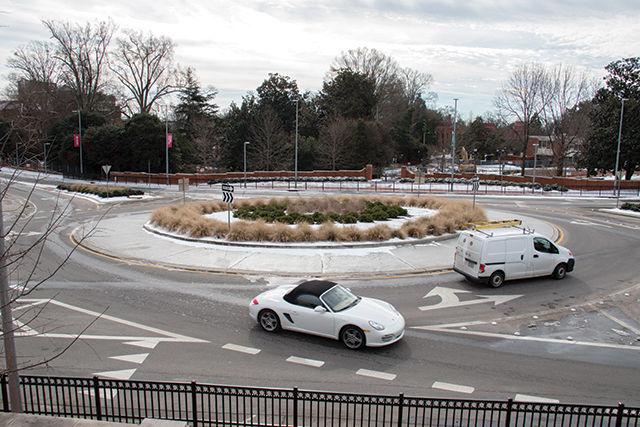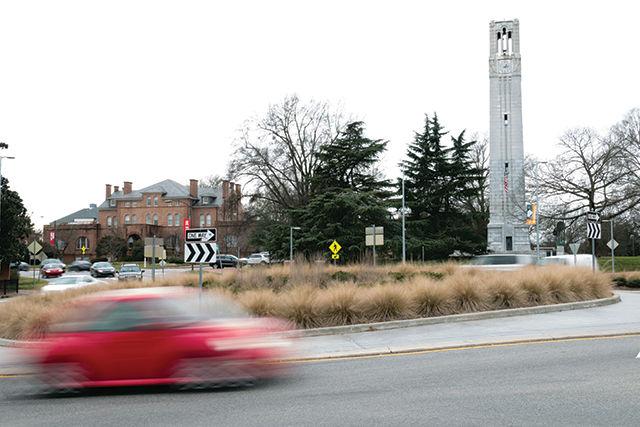Three roundabouts will be added to Hillsborough Street at the intersection of Rosemary and Shepherd Street, and Dixie Trail and Brooks Avenue, as part of Phase II of the Hillsborough Revitalization Project, which aims to make the area more accessible for pedestrians and cyclists. The entire project will cost about $12 million.
Construction on the project is scheduled to begin May 9 and should be completed by late summer 2017.
“A large part of the rationale for this project is that, left without any action, the traffic on Hillsborough would increase and keep building to the point where it would start coming to a crawl,” said Richard Dickie, project engineer for the Public Works Department for the City of Raleigh. “This is also one of the highest pedestrian corridors, with more pedestrian activity than any other part of the city.”
Four traffic signals on the street will be removed and replaced with roundabouts. The traffic signal at the intersection of Dan Allen Drive and Hillsborough Street will also be removed.
Construction will begin on the South side of the street, which is projected for completion in January 2017, and then begin again on the North side, projected for completion late summer of 2017.
“It will be a visual distraction, and there will be a lot going on,” Dickie said. “People will have to drive a little bit slower. We’ll be maintaining traffic signals throughout the project, and it’ll be as close to normal as we can make it.”
According to Dickie, roundabouts are a safer alternative to traffic lights because they reduce the stop-and-go nature of traffic. In this way, they make traffic slower but steadier. Oftentimes on Hillsborough Street, drivers will accelerate to beat the yellow light, which can then cause high-speed collisions.
“That traffic flow benefits pedestrians and cyclists, who will now have a dedicated bike lane on the corridor,” Dickie said. “There will also be an additional two feet of buffering to protect cyclists from opening car doors.”
In addition to the new roundabouts, Phase II of the Hillsborough Revitalization Project will increase sidewalk lengths to eight to 10 feet, bury power lines underground to clear up space, and install bike lanes.
“I think it’ll be great for pack pride,” said Jeff Murrison, executive director of Live It Up and the Hillsborough Street Community Service Corporation. “It’s really upgrading both the appearance and function of the street.”
City planners are referring to the proposed construction as a streetscape renovation and aim to make the area more aesthetically pleasing.
In order to make room for the new construction, the current three lanes of traffic on the Western side of Hillsborough Street will be reduced to two-lane traffic, eliminating the left turn lane. A median strip will be put in the middle of the road to direct traffic.
“If you can’t make left turns, you have to let people turn themselves around, hence the roundabouts,” Dickie said. “It’s a certain benefit, so instead of making a left turn you can just drive down, use the roundabout to turn around, and go that way.”
However, NC State Architecture Department Head Robin Abrams doubts if adding roundabouts will actually improve pedestrian conditions.
“I understand why they’re doing it because the data shows that it’s safer, but I think that it makes the route longer and is only safer because pedestrians and cyclists avoid the roundabouts,” Abrams said. “They take up too much space and make pedestrians second to traffic flow.”
Abrams has more than 30 years experience in city planning and urban design, and her department has partnered with the Raleigh Urban Design Center in the past.
“They’re also so new in this area that a lot of drivers don’t know they’re supposed to signal when they’re exiting a roundabout,” Abrams said. “And that can lead to accidents.”
According to Abrams, the placement of pedestrian signs is so that pedestrians are crossing at the point in the roundabout where drivers are more likely to accelerate.
“With Phase I, and the promise of what’s to come with Phase II, there’s been something of a land rush of property values,” Dickie said. “Property values along Hillsborough Street have gone up 69 percent in the past year since we’ve come out of the recession. That’s higher than the rest of Raleigh by a significant number, and it’s having a beneficial effect on the area.”
According to Dickie, those increases in property values will revitalize the area and make it more appealing for both current and new businesses.
“I would say that after Phase I we’ve seen an increase in economic development,” Murrison said. “You see more energy going to the redevelopment of the street, which will lead to private sector growth and the expansion of new businesses. I think Phase II is likely to continue that trend.”
With so much planned construction for this part of Hillsborough Street, residents of the area have voiced concerns over what the project will do to businesses in that area.
“One of my mandated missions for this is to manage the construction in a way that allows existing small businesses to remain in business, hopefully not suffer, and then once the construction is complete be in a position to thrive because there will be increased foot and bicycle traffic,” Dickie said. “It’ll transform this part of Hillsborough Street into a destination.”
However, Soto’s International Auto Repair, an auto repair shop located at the corner of Shepherd and Rosemary Street, will be forced to close and move locations due to the construction.
“We’ve done interviews with the media, which have done nothing. People have been complaining about this for the last two years,” said Tony Parker, an employee of Soto’s Auto Repair. “The city planners, they’re going to do whatever they want to do.”
A red car drives through the traffic circle at the intersection of Pullen Rd and Hillsborough St on January 20, 2016. City planners have expressed interest in converting two more intersections on Hillsborough St into roundabouts however some local residents are opposed to doing so.









